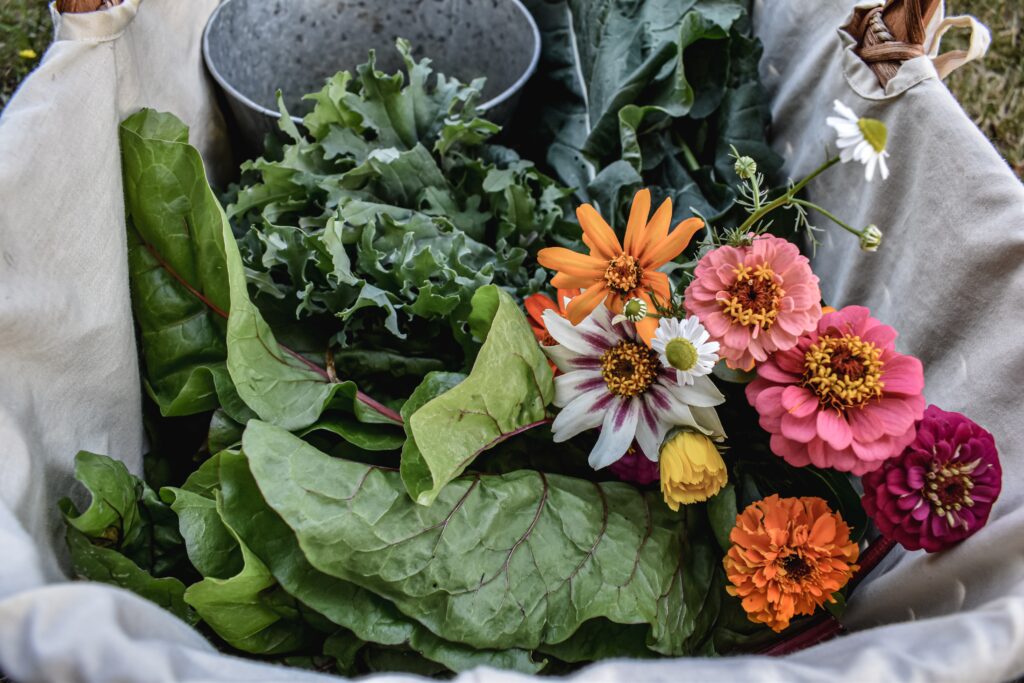The leaves are starting to take a turn toward their fall colors here in Ohio, but I’m still gathering zinnias in my garden. The tree in my neighbor’s backyard is dropping its leaves into mine while I water my bell peppers and pick red tomatoes. I cut off a zucchini from its vine, take it into my kitchen, and then I shred it into a bowl. As I squeeze the water from it through a white and green linen towel the temperature outside drops to a new coolness. Fall is approaching; fall is here.
Farmers are harvesting and it seems so am I. As the summer season closes and my plants take their last breath, I’ve been pondering the lessons I learned in my humble backyard while the sun was hot on my back.
A couple months ago, I reached into my tomato plant to prune a yellowing branch and got more than I bargained for. One bumblebee sting later and my hand swelled up into uselessness for the rest of the day. A few weeks after that, I peered into two open zucchini flowers and watched as bumblebees bathed themselves in pollen. They wallowed deep within the yellow petals like a dog rolls in the shady grass. In awe of the beauty and with a healthy fear of pain, I smiled, leaving them to their joy as I headed down the driveway for my morning walk.
I spent the whole summer tending to my garden. My coffee mug warmed my hand every morning as I walked by each plant checking for new blooms, growing fruit, or threatening bugs. I’ve gathered and arranged flowers with my oldest son, rejoiced over my first zucchini, tasted the sweetness of homegrown tomatoes, took in the colors of hummingbirds and butterflies as they drank from my flowers, and watched as seeds turned to seedlings that reached out from the deep.
But I’ve also cut vine borers out of my zucchini stems, watched my zinnias succumb to disease, chased squirrels from my yard, and nearly cried when my black swallowtail caterpillars suddenly disappeared. I’ve fought against beetles, squirrels, tomato pinworms, cutworms, stink bugs, and fungus. It’s been wild.
Gardening is full of all the joys and disappointments of life. It’s an exercise in patience and perseverance. It’s wondering Why am I spending my time digging larvae out of this plant? and being answered by the plump zucchini in your hand months later. What seemed dead, God miraculously sustained, and he used you to accomplish it. And it does feel like a miracle when you’ve so invested yourself.
But also gardening is an opportunity to learn to be open-handed to the God who’s sovereign over all of it. Because sometimes nearly all your tomatoes are stolen by squirrels or the seeds you planted never see the sun. We water and weed, but it’s God alone who controls the results. This truth leads us to worship both in the lack and the plenty.
When the peppers thrive and the flowers open with colors of merlot and coral, hot pink and yellow, well, we enter into a lesson God’s glory and goodness. Our hearts pivot to behold his beauty as we count the colors of one single bloom or look at the intricacy of its petals. We may have put seeds into the dirt, but it is he alone who brings the harvest.
I’ve found gardening to picture a spiritual reality—that we plant seeds of truth, share the gospel, seek to make disciples, confront evil in the world, stand up for what is right, and yet, any fruit that comes from our efforts is only produced by the Vine from which we are mere branches. Jesus is the True Vine whose roots sustain us all (John 15:1–11). So we abide in him, working together toward a common goal: that people would be saved and the Church would flourish. We trust him with the harvest, knowing he will accomplish all he has planned (Isaiah 46:10).
And despite the ways creation groans, what a beautiful harvest it is.

